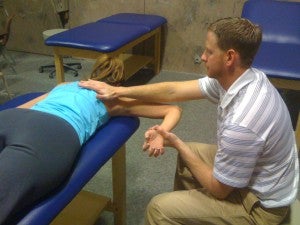Baseball, softball and volleyball players make a lot of overhead movements, which leaves their throwing shoulder and elbow at risk for injuries due to overuse. More and more youth baseball players are experiencing serious arm and shoulder injuries, such as rotator cuff and labrum tears and ulnar collateral ligament breakdown in the elbow. Some of these injuries require surgery to repair, but some are common in athletes in these specific sports and may be preventable, such as injuries as a result of glenohumeral internal rotation deficit (GIRD).
Research is showing that athletes can help prevent these negative overuse effects by stretching themselves properly to restore the internal rotation in the shoulder. Other researchers have looked at the cross-body and the sleeper stretching techniques, both stretching techniques that athletes can use without assistance from a clinician, such as an athletic trainer.
Boise State’s Dave Hammons, director of the athletic training program in the School of Allied Health Sciences, Department of Kinesiology has been looking at whether or not a previously untested stretching technique, the prone-passive technique, may help prevent GIRD.

In the prone-passive technique, the athlete lies face down on a table while a clinician moves the shoulder into internal rotation while stabilizing the scapula. Hammons thinks that the prone-passive technique may be another tool for athletes to use to prevent GIRD.
“Many baseball players, and even clinicians gravitate towards the sleeper stretch, however the cross-body has been demonstrated through prior research to elicit a greater improvement in internal rotation when compared to the sleeper stretch. The key is that those stretches can be conducted without assistance,” said Hammons. “We found the prone-passive technique was as effective as the cross body technique, but further research should focus on just baseball players who tend to exhibit higher levels of GIRD. I believe a different treatment approach for treating the soft tissues of the posterior shoulder should be used when treating those with significant internal rotation deficit and the prone-passive technique does this by applying a torsional stress versus the tensile stresses created by the cross-body technique.”
Hammons recently presented his findings, “Treatment Considerations for GIRD in the Overhead Athlete,” at the 2015 world congress for the World Federation of Athletic Training and Therapy (WFATT) in St. Louis, Missouri on June 21. WFATT is a coalition of national organizations of health care professionals in the fields of sport and exercise injury/illness prevention and treatment. The federation promotes the highest quality of health care and functional activity through the collaborative efforts of its members. The annual congress for the federation brings together athletic therapists, physical therapists, physiotherapists, medical doctors and other physical rehabilitation professionals from around the world.
Additionally, the Journal of Sports Medicine and Allied Health Sciences will publish Hammons’ study in its September issue.